twybrow
|
| posted on 19/3/13 at 08:45 PM |

|
|
Niche car symposium - titanium chassis porn!
I went to the Niche Vehicle Symposium today for work, at the Gaydon Heritage
Centre. A really interesting day, with talks from all manner of companies, including Morgan, Caterham and Ariel as well as plenty of EV and HEV
suppliers. Some great innovation on show, but what really caught my eye (and made for an excellent presentation) was the titanium Ariel Atom chassis.
Anyone who knows titanium will know just what a nightmare to make this would have been - they claim it was welded in the worlds largest argon inert
chamber - effectively a large clear pressurised tent, with 36 access gloves to weld inside so as to ensure a high quality, not brittle weld.
The cost and development required was frankly crazy, but I do love the engineering and thought that has gone into it for a 30% weight saving, and an
increase in torsional stiffness (larger diameter tubing to make up for the lower modulus of titanium)....
 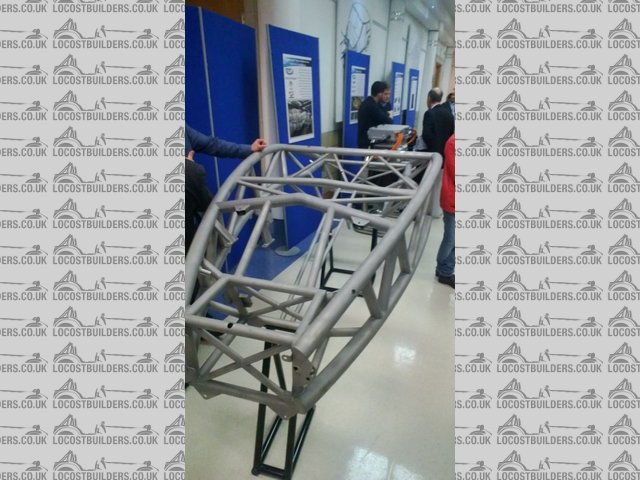
Ariel atom hi res 2
 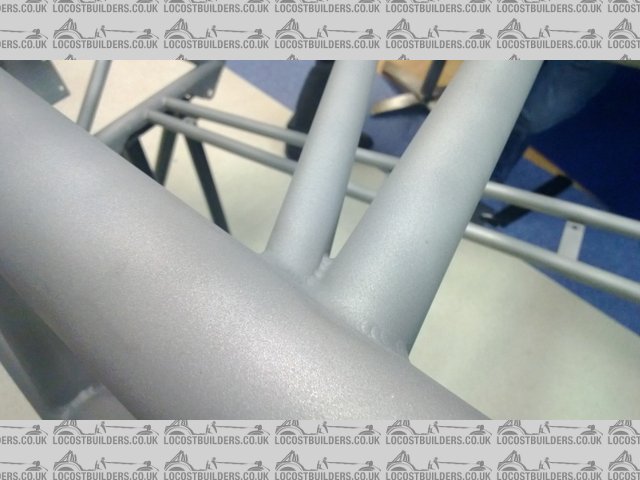
Ariel atom hi res
[Edited on 19/3/13 by twybrow]
|
|
|
|
|
indykid
|
| posted on 19/3/13 at 11:46 PM |

|
|
That's cool!
I bet the argon tent cost a pretty penny to purge and fill! A real money no object build
|
|
|
twybrow
|
| posted on 20/3/13 at 06:47 AM |

|
|
quote:
Originally posted by indykid
That's cool!
I bet the argon tent cost a pretty penny to purge and fill! A real money no object build
750,000 litres of Argon! :O
|
|
|
snapper
|
| posted on 20/3/13 at 08:25 AM |

|
|
And then the arc slips
A big hole in the tent
The gas and your career leaves at the same time
I eat to survive
I drink to forget
I breath to pi55 my ex wife off (and now my ex partner)
|
|
|
Slimy38
|
| posted on 20/3/13 at 08:51 AM |

|
|
This is definitely 'because they could' rather than 'because they should'... But definitely a round of applause to the
engineers for pushing the limits.
|
|
|
Sam_68
|
| posted on 20/3/13 at 11:11 AM |

|
|
quote:
Originally posted by Slimy38
This is definitely 'because they could' rather than 'because they should'...
Indeed.
Sorry to be the one who pisses on their firework, but maybe they'd have been better off investing the money in a properly triangulated
spaceframe, or possibly a stressed tub to sit within their cosmetic climbing frame instead of an abortion with effectively pre-buckled, curved main
tubes?
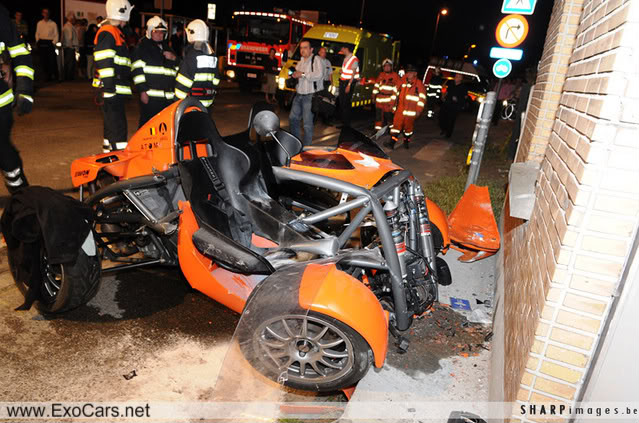
Fancy materials doth not good engineering make.
|
|
|
Peteff
|
| posted on 20/3/13 at 12:08 PM |

|
|
I like that, the whole car is a crumple zone.
yours, Pete
I went into the RSPCA office the other day. It was so small you could hardly swing a cat in there.
|
|
|
Sam_68
|
| posted on 20/3/13 at 02:18 PM |

|
|
quote:
Originally posted by Peteff
...the whole car is a crumple zone.
Yes, including the occupants! Dynamically adjustable wheelbase, too - all cutting-edge stuff!
And now, for a small extra premium, you can have it built from special, extra-crumpleable material?
We probably shouldn't joke about it, though - that one killed its driver, as I understand it. 
|
|
|
richardm6994
|
| posted on 20/3/13 at 02:34 PM |

|
|
Not a scratch on the wall tho!!!
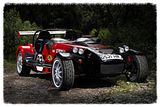
|
|
|
Alfa145
|
| posted on 20/3/13 at 05:06 PM |

|
|
I imagine that has fared a lot better than any of our kit cars would in similar circumstances.
Without knowing the details of the crash to say its a flawed design is a bit presumptious. Was it was a 120mph smash into a brick wall, then it has
stood up well or if it was a 20mph crash then it hasnt fared well at all.
Also if the driver did die, was it from injuries caused by the design of the structure or was it because of outside influences.
|
|
|
Sam_68
|
| posted on 20/3/13 at 05:22 PM |

|
|
quote:
Originally posted by Alfa145...to say its a flawed design is a bit presumptious.
I don't think so.
Curved tubes are going to give you lousy stiffness, period. They are, as I suggested above, effectively 'pre buckled', in that if you put
a compressive or tensile load onto either end, it results in a bending force in the tube itself.
Even ignoring the crash photograph, there's a long list of design shortcomings with the Atom's chassis, staring any reasonably competent
engineer in the face.
...But the photo does show an absolutely classic and predictable failure, where the large diameter (but curved) upper main tube has folded over
the much smaller (but straight) triangulation at the front bulkhead position... it's done exactly what any first year structures student
would have predicted it would do.
It's pretty much like folding a cardboard tube by bending it over your knee - you couldn't come up with a better way to make it fail if
you wanted to.
|
|
|
Alfa145
|
| posted on 20/3/13 at 05:27 PM |

|
|
According to Werners post here a few years ago, it was probably 120kph not mph and both survived albeit with broken legs:
http://www.locostbuilders.co.uk/viewthread.php?tid=91300
If that's correct I'd say that's quite a good result, considering.
|
|
|
Slimy38
|
| posted on 20/3/13 at 06:24 PM |

|
|
I'm going to admit something now, it took me a few minutes to figure out where the engine ended up as there didn't seem to be enough room
left in the front... 
|
|
|
Sam_68
|
| posted on 20/3/13 at 08:28 PM |

|
|
quote:
Originally posted by Alfa145
According to Werners post here a few years ago, it was probably 120kph not mph and both survived albeit with broken legs.
Good that they survived, obviously (I'd been told differently by an Atom owner on another forum), but the fact remains that the mode of failure
was entirely wrong. If the car had been designed so that the front of the chassis was a deformable structure and the cockpit was rigid, they'd
have walked away.
And from the discussion on the thread you linked to, it would seem that the impact was with the concrete kerb immediately in front of the car -
I'd say that a speed of 120kph (about 75mph) at the point of impact is inconceivably unlikely - the basic laws of physics would have
meant that at that speed the car would have simply pitched over the top of the kerb and into the house in front of it (which is clearly untouched by
the impact).
Notice that the front of the upper main rails don't appear to have suffered any direct impact damage, so they were buckled by being pulled back
by either the lower rails or the wheels impacting something, and it hasn't even buckled a wheel. I mean, hell, you can buckle an alloy
wheel hitting a bad pothole, if you're unlucky. Straight into a concrete kerb at 75mph - pull the other one!!
This pic from the other thread is even more scary, if that's possible; the bottom main chassis rails have clearly folded up even more
dramatically than the top ones, again with the small diameter triangulation acting as a 'fulcrum':
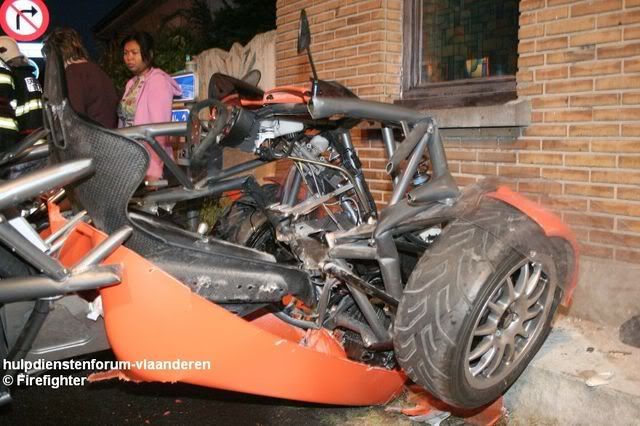
Edited to add: no... I tell a lie. If you look very, very carefully, you can see that the front wheel has slightly dented its rim! 
[Edited on 20/3/13 by Sam_68]
|
|
|
adithorp
|
| posted on 20/3/13 at 09:23 PM |

|
|
To be fair it's impossible to tell what happened to the chassis before the fire brigade cut out a whole load of it to extract the occupants and
then shoved it all together to clear the road. There's at least a meter of top chassis rail missing, unless you think the scuttle attaches
direct to the rear bulkhead.
"A witty saying proves nothing" Voltaire
http://jpsc.org.uk/forum/
|
|
|
vanepico
|
| posted on 20/3/13 at 09:28 PM |

|
|
It's like driving a Rover 100, your feet are the crumple zone 
Except of course the rover 100 had the power of 2 rampaging children
__________________________
Will CAD for food/money/beer...
|
|
|
Sam_68
|
| posted on 20/3/13 at 09:47 PM |

|
|
quote:
Originally posted by adithorp
To be fair it's impossible to tell what happened to the chassis before the fire brigade cut out a whole load of it to extract the occupants and
then shoved it all together to clear the road.
Are you suggesting that the fire brigade put those buckles in the front main frame rails?
quote:
Originally posted by adithorpThere's at least a meter of top chassis rail missing, unless you think the scuttle attaches direct to
the rear bulkhead.
Note that the fire brigade only cut one side of the car. The main trellis on the left hand side has not been cut, and comparison side-side appears to
suggest that there wasn't a huge amount of distortion in the section that was cut away (note that the wheels have been pushed back almost
equally on either side and that the distortion of the front section of frame - carrying the dampers - is quite symmetrical).

In other words, it seems fairly obvious that the whole thing folded up quite evenly just in front of the instrument bulkhead, in response to a fairly
direct, head-on impact.
|
|
|
adithorp
|
| posted on 20/3/13 at 10:15 PM |

|
|
What I'm suggesting is only an idiot would come to a definitive conclusion about structural strength based on a few photos posted on the
internet.
"A witty saying proves nothing" Voltaire
http://jpsc.org.uk/forum/
|
|
|
Sam_68
|
| posted on 21/3/13 at 07:28 AM |

|
|
How about based on substantial formal training in structures, visual anaylsis of the chassis and anecdotal evidence from other sources?
|
|
|
Furyblade_Lee
|
| posted on 21/3/13 at 07:38 PM |

|
|
I would be interested to know how a kitcar that has hit a house at 75mph would be "expected" to look? Any ideas?
|
|
|
Sam_68
|
| posted on 21/3/13 at 07:44 PM |

|
|
quote:
Originally posted by Furyblade_Lee I would be interested to know how a kitcar that has hit a house at 75mph would be
"expected" to look? Any ideas?
Not like that one.
Which didn't.
|
|
|
Furyblade_Lee
|
| posted on 21/3/13 at 08:36 PM |

|
|
was there an official impact speed released?
|
|
|
Furyblade_Lee
|
| posted on 21/3/13 at 09:23 PM |

|
|
Thats the first time I have seen that photo properly and not on my iphone, that is one bloody huge kerb and not going to give a mm. At least if he had
hit the house it would probobly given a foot or two through the wall and the nose ending up in the lounge....
|
|
|
Sam_68
|
| posted on 21/3/13 at 09:38 PM |

|
|
quote:
Originally posted by Furyblade_Lee was there an official impact speed released?
Not to my knowledge. 
- Neither was there so much as a chip or a scuff on the wall of the house that you are suggesting the car impacted at 75mph.
- Neither was there the slightest damage to the front ends of the upper main chassis tubes, which would have been the first structure to hit
that wall at 75mph.
- Neither was there any damage whatsoever to the fibreglass cycle mudguards, and only minimal damage to the glassfibre nosecone, which you can
see stacked to the left hand side of the wreck (pity the chassis wasn't as tough as the fibreglass panels, huh?).
All of which tends to suggest that the car hit the kerb, not something high enough to damage the structure more than a few inches from the ground
(like, for example, a house  ). And as I pointed out above, if it hit the kerb at anything like the sort of high speed being suggested,
simple physics (the momentum of a large mass with its CoG 20" off the deck) would have meant the car would have been pitched over the kerb and
into the wall. ). And as I pointed out above, if it hit the kerb at anything like the sort of high speed being suggested,
simple physics (the momentum of a large mass with its CoG 20" off the deck) would have meant the car would have been pitched over the kerb and
into the wall.
But of course you're going to argue with anything I say as a matter of religious faith. Nice to see you're interested enough in my
opinion that you've almost boosted your post count into double figures after over a year, though. 
Oh... and to answer your question: what a properly designed car would look like if it impacted a wall at 75mph would demonstrate the
progressive and total collapse of the deformable front crash structure (which doesn't exist on an Atom), followed - once the crash structure had
been sacrificed - by the progressive and energy-absorbing collapse of the main structure.
What a properly designed car wouldn't look like would be something that literally folded up on a single plane, right around the
occupant's legs, with relatively minimal distortion to the rest of the structure.
Still, shiny titanium thing make it all better, eh? 
|
|
|
sdh2903
|
| posted on 21/3/13 at 09:50 PM |

|
|
With the atom being type approved would it not have to have gone through crash testing to be allowed to sell abroad?
|
|
|









